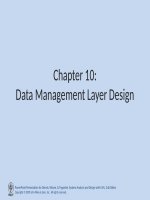Lecture Systems analysis and design with UML (3 e) Chapter 12 Physical architecture layer design
Bạn đang xem bản rút gọn của tài liệu. Xem và tải ngay bản đầy đủ của tài liệu tại đây (278.57 KB, 24 trang )
Chapter 12:
Physical Architecture Layer
Design
PowerPoint Presentation for Dennis, Wixom, & Tegarden Systems Analysis and Design with UML, 3rd Edition
Copyright © 2009 John Wiley & Sons, Inc. All rights reserved.
Objectives
• Understand the different physical architecture components.
• Understand server-based, client-based, and client–server
physical architectures.
• Be familiar with distributed objects computing.
• Be able to create a network model using a deployment
diagram.
• Understand how operational, performance, security, cultural,
and political requirements affect the design of the physical
architecture layer.
• Be familiar with how to create a hardware and software
specification.
PowerPoint Presentation for Dennis, Wixom, & Tegarden Systems Analysis and Design with UML, 3rd Edition
Copyright © 2009 John Wiley & Sons, Inc. All rights reserved.
Introduction
• Most modern systems span two or more
networked computers
• The physical architecture layer design
specifies
– How the system will be distributed across the
computers
– What hardware and software will be used
• Most systems’ design is constrained by
existing systems and networks
PowerPoint Presentation for Dennis, Wixom, & Tegarden Systems Analysis and Design with UML, 3rd Edition
Copyright © 2009 John Wiley & Sons, Inc. All rights reserved.
ELEMENTS OF THE PHYSICAL
ARCHITECTURE LAYER
PowerPoint Presentation for Dennis, Wixom, & Tegarden Systems Analysis and Design with UML, 3rd Edition
Copyright © 2009 John Wiley & Sons, Inc. All rights reserved.
Architectural Components
• Software components
– Data storage
– Data access logic
– Application logic
– Presentation logic
• Hardware components
– Computers (clients, servers)
– Networks
PowerPoint Presentation for Dennis, Wixom, & Tegarden Systems Analysis and Design with UML, 3rd Edition
Copyright © 2009 John Wiley & Sons, Inc. All rights reserved.
Server-Based Architectures
• The server performs all four application
functions
• The client only needed a monitor, a keyboard,
and a communications device (e.g. modem)
Data Storage
Data Access Logic
Application Logic
Presentation Logic
PowerPoint Presentation for Dennis, Wixom, & Tegarden Systems Analysis and Design with UML, 3rd Edition
Copyright © 2009 John Wiley & Sons, Inc. All rights reserved.
Client-Based Architectures
• All logic resides on the client computer
• A separate computer may hold the data
• Simple to develop, but difficult to maintain
Data Access Logic
Application Logic
Presentation Logic
Data Storage
PowerPoint Presentation for Dennis, Wixom, & Tegarden Systems Analysis and Design with UML, 3rd Edition
Copyright © 2009 John Wiley & Sons, Inc. All rights reserved.
Client-Server Architectures
• Balance processing between client and server
• Predominant architecture in modern systems
• Amount of client processing varies
– Thin clients do only presentation logic
– Thick clients do presentation and application
Application Logic
Presentation Logic
Data Storage
Data Access Logic
PowerPoint Presentation for Dennis, Wixom, & Tegarden Systems Analysis and Design with UML, 3rd Edition
Copyright © 2009 John Wiley & Sons, Inc. All rights reserved.
Client-Server Tiers
• Client server architectures can have two or
more tiers depending on application logic
partitioning
– 2-tier: all application and data logic on one server
– 3-tier: application logic on one server, data logic
on another
– 4-tier: application logic split among two servers,
data logic on another
• Sometimes called an n-tier architecture
PowerPoint Presentation for Dennis, Wixom, & Tegarden Systems Analysis and Design with UML, 3rd Edition
Copyright © 2009 John Wiley & Sons, Inc. All rights reserved.
Distributed Objects Computing
• Next generation of client-server computing
• The client need not know which server to call
• Middleware intercepts the client request and
sends it to the appropriate server
• Three competing approaches
– CORBA
– Enterprise Java Beans
– .NET
PowerPoint Presentation for Dennis, Wixom, & Tegarden Systems Analysis and Design with UML, 3rd Edition
Copyright © 2009 John Wiley & Sons, Inc. All rights reserved.
Selecting a Physical Architecture
•
•
•
•
•
•
Cost of infrastructure
Cost of development
Ease of development
Interface capabilities
Control and security
Scalability
PowerPoint Presentation for Dennis, Wixom, & Tegarden Systems Analysis and Design with UML, 3rd Edition
Copyright © 2009 John Wiley & Sons, Inc. All rights reserved.
Architecture Characteristics
Server-Based
Client-Based
Client-Server
Cost of
infrastructure
Very high
Medium
Low
Cost of
development
Medium
Low
High
Ease of
development
Low
High
Low-Medium
Interface
capabilities
Low
High
High
Control and
Security
High
Low
Medium
Scalability
Low
Medium
High
PowerPoint Presentation for Dennis, Wixom, & Tegarden Systems Analysis and Design with UML, 3rd Edition
Copyright © 2009 John Wiley & Sons, Inc. All rights reserved.
INFRASTRUCTURE DESIGN
PowerPoint Presentation for Dennis, Wixom, & Tegarden Systems Analysis and Design with UML, 3rd Edition
Copyright © 2009 John Wiley & Sons, Inc. All rights reserved.
Deployment Diagram
• Represent relationships between hardware
components of an information system
• Elements of a deployment diagram
– Nodes: a computational resource
– Artifacts: a piece of the information system which
will be installed on a node
– Communication paths: a communication link such
as a network connection or a USB cable
PowerPoint Presentation for Dennis, Wixom, & Tegarden Systems Analysis and Design with UML, 3rd Edition
Copyright © 2009 John Wiley & Sons, Inc. All rights reserved.
Sample Deployment Diagram
PowerPoint Presentation for Dennis, Wixom, & Tegarden Systems Analysis and Design with UML, 3rd Edition
Copyright © 2009 John Wiley & Sons, Inc. All rights reserved.
Network Model
• Shows the major components of the
information system and their geographic
locations throughout the organization
• Purposes of the network model:
– To convey the complexity of the system
– To show how the system’s software components
will fit together
PowerPoint Presentation for Dennis, Wixom, & Tegarden Systems Analysis and Design with UML, 3rd Edition
Copyright © 2009 John Wiley & Sons, Inc. All rights reserved.
Sample Network Model
PowerPoint Presentation for Dennis, Wixom, & Tegarden Systems Analysis and Design with UML, 3rd Edition
Copyright © 2009 John Wiley & Sons, Inc. All rights reserved.
NONFUNCTIONAL REQUIREMENTS
PowerPoint Presentation for Dennis, Wixom, & Tegarden Systems Analysis and Design with UML, 3rd Edition
Copyright © 2009 John Wiley & Sons, Inc. All rights reserved.
Nonfunctional Requirement Types
•
•
•
•
Operational
Performance
Security
Cultural and Political
PowerPoint Presentation for Dennis, Wixom, & Tegarden Systems Analysis and Design with UML, 3rd Edition
Copyright © 2009 John Wiley & Sons, Inc. All rights reserved.
Operational Requirements
PowerPoint Presentation for Dennis, Wixom, & Tegarden Systems Analysis and Design with UML, 3rd Edition
Copyright © 2009 John Wiley & Sons, Inc. All rights reserved.
Performance Requirements
PowerPoint Presentation for Dennis, Wixom, & Tegarden Systems Analysis and Design with UML, 3rd Edition
Copyright © 2009 John Wiley & Sons, Inc. All rights reserved.
Security Requirements
PowerPoint Presentation for Dennis, Wixom, & Tegarden Systems Analysis and Design with UML, 3rd Edition
Copyright © 2009 John Wiley & Sons, Inc. All rights reserved.
Cultural & Political Requirements
PowerPoint Presentation for Dennis, Wixom, & Tegarden Systems Analysis and Design with UML, 3rd Edition
Copyright © 2009 John Wiley & Sons, Inc. All rights reserved.
Summary
• Elements of the Physical Architecture Layer
• Infrastructure Design
• Nonfunctional Requirements
PowerPoint Presentation for Dennis, Wixom, & Tegarden Systems Analysis and Design with UML, 3rd Edition
Copyright © 2009 John Wiley & Sons, Inc. All rights reserved.









